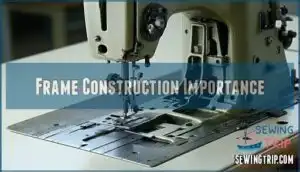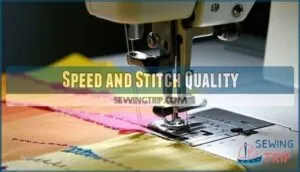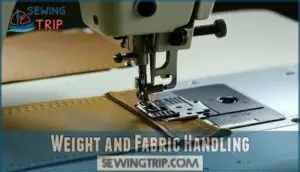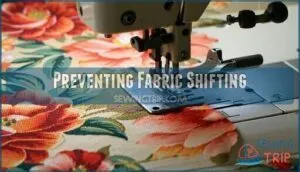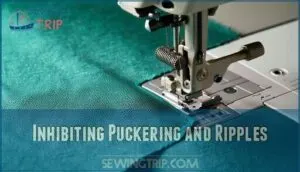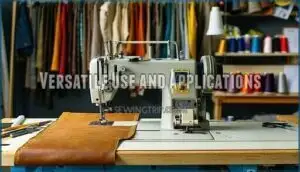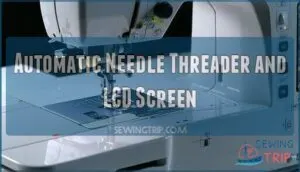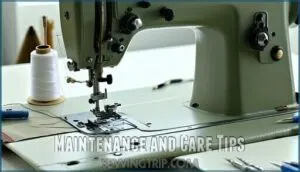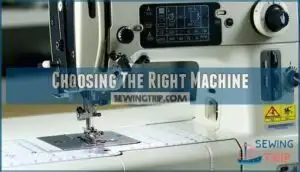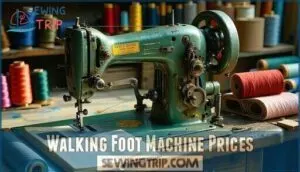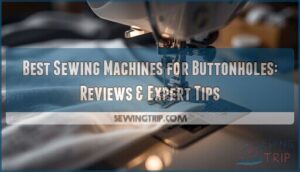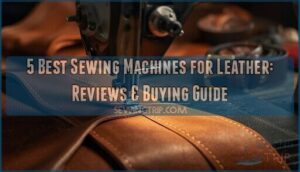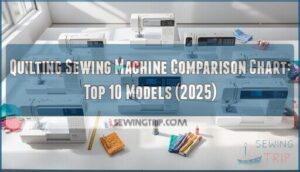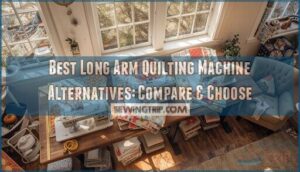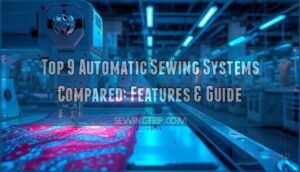This site is supported by our readers. We may earn a commission, at no cost to you, if you purchase through links.
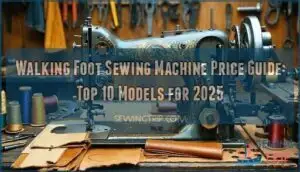 A walking foot sewing machine’s price varies widely, typically ranging from $150 to $3,000, depending on whether it’s a basic model or an industrial-grade powerhouse.
A walking foot sewing machine’s price varies widely, typically ranging from $150 to $3,000, depending on whether it’s a basic model or an industrial-grade powerhouse.
For light-duty work, the Singer Heavy Duty 4452 is a great pick, starting around $200, offering solid performance for home projects.
On the industrial side, options like the JUKI DNU-1541, ideal for upholstery and thick materials, can cost $1,500 or more.
Keep an eye on features like stitch speed, motor power, and build quality—these impact both cost and performance.
If precision and durability matter, investing in a sturdy machine often pays off in the long run.
Table Of Contents
- Key Takeaways
- Walking Foot Sewing Basics
- Top 10 Walking Foot Machines
- 1. Juki HZL F600 Sewing Quilting Machine
- 2. JUKI DNU 1541 Walking Foot Machine
- 3. SINGER Heavy Duty Sewing Machine
- 4. SINGER Quantum Stylist Sewing Quilting Machine
- 5. JUKI DU 1181N Industrial Sewing Machine
- 6. Consew Upholstery Walking Foot Sewing Machine
- 7. Consew 206RB-5 Industrial Sewing Machine
- 8. Consew CP206RL Walking Foot Sewing Machine
- 9. Brother CS7000i Sewing Quilting Machine
- 10. Brother CS6000i Sewing and Quilting Machine
- Key Features and Benefits
- Maintenance and Care Tips
- Choosing The Right Machine
- Walking Foot Machine Prices
- Frequently Asked Questions (FAQs)
- Conclusion
Key Takeaways
- You’ll find walking foot sewing machines priced between $150 and $3,000, depending on features and whether it’s a home or industrial model.
- Budget-friendly options like the Singer Heavy Duty 4452 start around $200, while industrial machines like the JUKI DNU-1541 can cost $1,500 or more.
- High-end machines offer faster speeds (2,500-3,300 SPM), better build quality, and extras like automatic needle threaders and tension control for professional results.
- Match your machine choice to your project needs—basic home models work for light-duty tasks, while heavy-duty and industrial models handle leather, canvas, and upholstery.
Walking Foot Sewing Basics
You’ll need to understand how walking foot mechanisms work to choose the right machine for your projects.
These specialized machines use dual feeding systems that move fabric layers together, preventing shifting and puckering when you’re working with thick materials like leather, canvas, or multiple quilt layers.
Frame Construction Importance
Metal Frame Durability forms your walking foot machine’s backbone.
You’ll notice industrial sewing machine models use cast iron or steel frames that absorb vibration reduction during heavy-duty operations.
Weight Impact matters – heavier frames stay planted while lighter portable units may bounce.
Frame Material Types directly affect your sewing machine price, with solid construction ensuring years of reliable heavy duty sewing performance and durability.
Speed and Stitch Quality
Your walking foot machine’s speed directly impacts stitch consistency and fabric feed quality.
Stitch consistency and fabric feed quality soar with the right walking foot machine speed, ensuring professional results every time.
Most industrial sewing machines deliver 2,500-3,300 SPM, while home models typically reach 800-1,100 SPM.
Higher speeds don’t always mean better results – tension control and needle quality matter more.
Find the sweet spot where your machine maintains even stitches without causing fabric distortion or thread breaks.
Weight and Fabric Handling
Heavier walking foot machines deliver superior fabric handling for multiple layers and heavyduty fabrics.
Machine weight directly impacts stitch quality—lightweight portable options work fine for thin materials, but you’ll need substantial mass for leather and canvas.
Material versatility improves with increased weight since the machine won’t bounce or shift when tackling fabric thickness variations during heavy duty sewing projects, which requires a machine with sufficient mass to handle multiple layers.
Top 10 Walking Foot Machines
You’ll find machines ranging from portable options like the REX 607Z at 1,200 stitches per minute to industrial powerhouses like the Consew 206RB-5 that cranks out 3,300 stitches per minute.
These ten models cover everything from beginner-friendly computerized machines with hundreds of built-in stitches to heavy-duty industrial units that’ll handle leather, canvas, and multi-layer quilting projects without breaking a sweat, including those that can handle multi-layer quilting.
1. Juki HZL F600 Sewing Quilting Machine
Versatility defines the Juki HZL-F600, making it perfect for beginners and experienced sewers alike.
You’ll get 225 built-in stitches, including 16 professional buttonholes and four lettering fonts.
The machine weighs 21.6 pounds with dimensions of 17.5 x 11.4 x 8.2 inches.
It sews up to 900 stitches per minute with a maximum stitch width of 7mm.
The automatic needle threader, LED lighting, and knee lifting lever give you complete control over every project you tackle.
Best For: Beginner and experienced sewers looking for a versatile and user-friendly machine with professional stitching capabilities.
- 225 built-in stitches, including professional buttonholes and lettering fonts.
- Automatic needle threader and LED lighting for ease of use.
- High sewing speed of up to 900 stitches per minute.
- Mixed reviews on the reliability of the thread cutter.
- Issues reported with bobbin hook timing.
- Extended warranty communication can be difficult.
2. JUKI DNU 1541 Walking Foot Machine
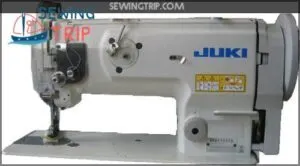
You’re looking at serious industrial power with the JUKI DNU-1541.
This machine cranks out 2,500 stitches per minute while handling heavy materials like leather and canvas with ease.
The double-tension mechanism keeps your stitches consistent, even on thick layers, and the rectangular feed motion prevents needle fraying, extending your needle life.
At 80 pounds, it’s built to stay put during high-speed operation, and it’s designed for professionals who need reliability and speed in demanding sewing environments.
Best For: Professional sewers and industrial applications requiring speed, reliability, and the ability to handle heavy materials like leather and canvas.
- Heavy 80-pound build may make it difficult to move.
- Requires proper setup and maintenance for optimal performance.
- Additional features like T-Leg table or needle position motor cost extra.
- High sewing speed of 2,500 stitches per minute for efficient operation.
- Double-tension mechanism ensures consistent stitching, even on thick layers.
- Rectangular feed motion prevents needle fraying, extending needle life.
3. SINGER Heavy Duty Sewing Machine
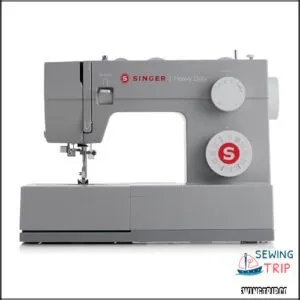
Power meets affordability in the SINGER Heavy Duty 4452, making it a standout choice for budget-conscious sewers.
You’ll get 32 built-in stitches and impressive 1,100 stitches per minute speed with enhanced piercing power that tackles multiple fabric layers effortlessly.
The full metal frame provides rock-solid stability during heavy-duty projects, while the built-in needle threader saves time and frustration.
At just 14.6 pounds, it’s surprisingly portable for such a robust machine, delivering professional results without breaking the bank, and offering an excellent combination of heavy-duty performance.
Best For: Budget-conscious sewers who need a durable, high-performance machine for heavy-duty projects and versatile stitching needs.
- Limited to 32 built-in stitches compared to other models.
- Short 90-day warranty on adjustments and 2 years on the motor.
- Works only with 120V, which may require a voltage converter in certain regions.
- Strong motor with enhanced piercing power for thick fabrics.
- Lightweight and portable at just 14.6 pounds.
- Delivers professional stitching results with 1,100 stitches per minute.
4. SINGER Quantum Stylist Sewing Quilting Machine
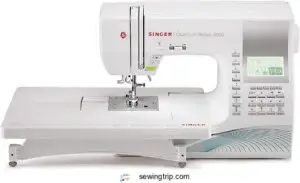
Packed with 600 built-in stitches and 1,172 stitch applications, the SINGER Quantum Stylist 9960 delivers exceptional versatility for your creative projects.
You’ll appreciate the automatic needle threader and LCD screen that simplify operation, while the 850 stitches per minute speed keeps productivity high.
At 18.2 pounds with a durable metal frame, this machine handles everything from delicate fabrics to heavy materials.
The included accessories package adds tremendous value, though some users report issues with the automatic thread cutter function requiring occasional troubleshooting.
Best For: Creative individuals, sewing enthusiasts, and experienced quilters seeking versatility and advanced features in a durable machine.
- 600 built-in stitches and 1,172 stitch applications for creative flexibility.
- Durable metal frame and high-speed stitching handle various materials efficiently.
- Extensive accessories package included for added value.
- Automatic thread cutter can be finicky and may need troubleshooting.
- Heavier than some models, at 18.2 pounds, limiting portability.
- Can be overwhelming for absolute beginners due to its advanced features.
5. JUKI DU 1181N Industrial Sewing Machine
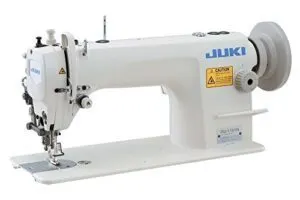
Built like a tank, the JUKI DU 1181N delivers serious industrial performance at $1,375-$1,600.
You’ll get 2,000 stitches per minute with its top and bottom feed mechanism that handles light to mid-weight materials beautifully.
The 18.78 x 7.008-inch throat space gives you room to maneuver, while the double-capacity hook keeps you sewing longer between bobbin changes.
Assembly’s required, but the automatic lubrication system means less maintenance headaches once you’re up and running.
Best For: Professionals or hobbyists seeking a durable industrial sewing machine for light to mid-weight materials with high-speed performance.
- High sewing speed of 2,000 stitches per minute.
- Double-capacity hook for longer sewing sessions between bobbin changes.
- Automatic lubrication system for reduced maintenance.
- Assembly required, with no instructions included in the package.
- Not suitable for very thick materials or very light fabrics.
- Industrial clutch motor generates significant noise.
6. Consew Upholstery Walking Foot Sewing Machine
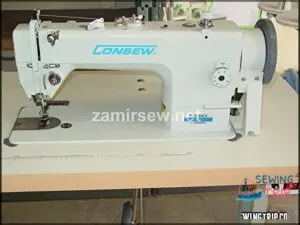
The Consew’s upholstery-focused design makes it perfect for heavy-duty projects like furniture restoration and marine applications.
You’ll handle leather, vinyl, canvas, and coated materials with ease at speeds up to 3,000 stitches per minute.
The adjustable oil pump system keeps everything running smoothly, while the large horizontal hook accommodates thick threads.
At over 185 pounds, this machine won’t budge during intensive work sessions.
Though assembly requires patience and the learning curve is steep, you’ll appreciate the professional results once you’re up and running, which is ideal for furniture restoration.
Best For: Professionals and experienced users working on heavy-duty upholstery, leather, or marine sewing projects.
- Requires challenging assembly and setup.
- Steep learning curve for beginners.
- Reports of shipping and packaging issues, including damaged components.
- Handles a wide range of materials, including leather, vinyl, and canvas.
- High stitching speed of up to 3,000 stitches per minute.
- Adjustable oil pump system ensures smooth operation and durability.
7. Consew 206RB-5 Industrial Sewing Machine
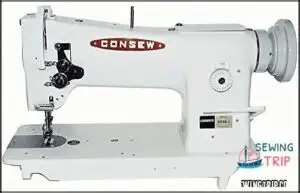
Speed meets precision with the Consew 206RB-5, delivering an impressive 3,300 stitches per minute.
This flatbed machine handles heavyweight materials like leather, canvas, and vinyl with ease, thanks to its 14mm foot clearance and 10mm maximum stitch length.
You’ll appreciate the triple feed mechanism that keeps thick layers aligned perfectly.
While it excels at flat items like wallets and upholstery work, it’s not ideal for circular projects.
The included table and servo motor make this a complete package for serious sewers.
Best For: Industrial sewers and professionals working with heavy-duty materials like leather, canvas, and vinyl, particularly for flat items such as wallets or upholstery.
- Not suitable for circular items like bags and hats.
- Requires self-assembly with limited instruction support.
- Table top may require modifications due to fit issues.
- Triple feed mechanism ensures precision with thick layers.
- Handles heavyweight materials efficiently.
- Comes as a complete package with a table and servo motor.
8. Consew CP206RL Walking Foot Sewing Machine
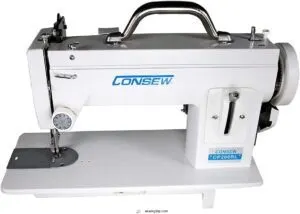
At $450, this portable powerhouse delivers professional results without breaking the bank.
You’ll get 800 stitches per minute with a 6mm stitch length that handles everything from leather to canvas.
The horizontal oscillating hook and reverse stitching give you complete control over your projects.
Weighing just 41 pounds, it’s easy to transport between job sites.
The built-in motor eliminates external components, while the solid metal construction guarantees years of reliable service for upholstery and heavy-duty applications.
This makes it ideal for preventing fabric shifting during complex projects, providing complete control over your work.
Best For: Professionals and hobbyists needing a portable, durable sewing machine for heavy-duty tasks like leather, canvas, and upholstery projects.
- Setup with accessories can reach up to $800, increasing costs.
- Limited to a maximum stitch length of 6mm.
- May not be suitable for extremely high-speed industrial tasks.
- Portable and lightweight at 41 pounds with a built-in motor.
- Handles light to heavy-weight materials with precision.
- Offers reverse stitching and up to 800 stitches per minute.
9. Brother CS7000i Sewing Quilting Machine
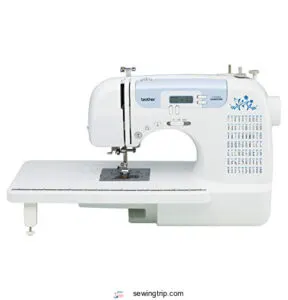
The Brother CS7000i stands out with its 70 built-in stitches and backlit LCD display that makes stitch selection effortless.
You’ll appreciate the automatic needle threader and drop-in bobbin system that saves time on setup.
This machine includes a walking foot among its 10 sewing feet, plus a wide extension table perfect for quilting projects.
The hard protective case adds portability, while the 25-year warranty provides peace of mind.
It’s lightweight yet handles everything from silk to heavy denim with consistent results.
Best For: Beginners and intermediate sewists looking for an affordable, feature-rich machine with quilting capabilities.
- Sensitive to power surges, requiring a surge protector for reliable use.
- Default needle position is on the left for straight stitching, requiring adjustment for center position.
- No straight stitch foot included, requiring additional purchase for some tasks.
- 70 built-in stitches with a user-friendly backlit LCD display for easy selection.
- Automatic needle threader and quick-set bobbin save time on setup.
- Lightweight and portable design with a protective case and wide extension table.
10. Brother CS6000i Sewing and Quilting Machine
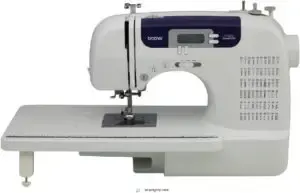
When value meets versatility, the Brother CS6000i delivers solid performance without breaking the bank.
This computerized machine features 60 built-in stitches, including decorative options and seven auto-size buttonholes.
You’ll appreciate its automatic needle threader and jam-resistant drop-in bobbin system that streamline your workflow.
The LCD screen makes stitch selection straightforward, while the included hard case and wide table enhance portability and workspace.
With a 25-year limited warranty and lifetime technical support, it’s perfect for beginners and hobbyists tackling quilting projects.
Best For: Beginners and hobbyists looking for a budget-friendly sewing machine for light sewing and quilting tasks.
- 60 built-in stitches with automatic needle threader and jam-resistant bobbin system
- Lightweight, portable, and easy to use, with a wide table included
- Lifetime technical support and 25-year limited warranty
- Not suitable for heavy-duty fabrics or professional tasks
- Limited advanced features for experienced users
- Warranty is voided if used outside the U.S.
Key Features and Benefits
You’ll discover that walking foot machines offer several key advantages that set them apart from standard sewing machines.
These features include preventing fabric layers from shifting during stitching, eliminating puckering and ripples in your seams, and providing the versatility to handle everything from delicate silks to heavy leather with professional results, including preventing fabric layers from shifting during stitching.
Preventing Fabric Shifting
Your walking foot sewing machine‘s dual feed system creates superior fabric alignment by gripping both top and bottom layers simultaneously.
This even feed mechanism eliminates slippage between materials, ensuring layer stability throughout your project.
The synchronized fabric feeding reduces friction while maintaining consistent tension control, preventing bunching reduction issues that plague standard presser feet when handling multiple fabric layers, which is a key aspect of the machine’s ability to provide superior fabric alignment.
Inhibiting Puckering and Ripples
Two common fabric nightmares disappear when you’re using a walking foot machine.
Two fabric nightmares vanish instantly: puckering and ripples—achieve flawless, professional results with your walking foot machine every time.
The even feed mechanism maintains consistent thread tension while the differential feed prevents bunching.
You’ll notice your presser foot applies uniform pressure across fabric weight variations.
Proper stitch length settings eliminate those frustrating ripples that plague regular machines.
No more puckering means professional results every time.
Using stabilizers and interfacing can further help in preventing fabric puckering.
Versatile Use and Applications
Your walking foot machine tackles projects that would make standard machines struggle.
These industrial powerhouses excel at:
- Quilting Applications – Multi-layer fabrics stay perfectly aligned
- Upholstery Projects – Heavy-duty materials feed smoothly without bunching
- Leather Sewing – Thick hides move effortlessly through the feed system
- Canvas Work – Outdoor fabrics maintain consistent stitch quality throughout
This versatility makes your investment worthwhile across multiple crafting disciplines.
Automatic Needle Threader and LCD Screen
Advanced sewing machine features like automatic needle threader and LCD screen elevate your walking foot sewing machine experience.
Threading automation saves time and reduces eye strain during long projects. Screen visibility shows stitch patterns, tension settings, and speed controls clearly for better user experience.
Many users benefit from an automatic threading device.
| Feature | Entry Level | Mid-Range | Premium |
|---|---|---|---|
| Automatic Needle Threader | Manual only | Push-button | One-touch |
| LCD Screen Size | None | 2 inches | 4+ inches |
| Display Information | LED lights | Basic settings | Full library |
| Threader Benefits | Limited | Good | Excellent |
| Sewing Machine Price | $200-400 | $500-800 | $1000+ |
These enhancements justify higher sewing machine price points through improved functionality.
Maintenance and Care Tips
You’ll extend your walking foot machine’s lifespan and maintain professional-quality stitches when you follow proper maintenance routines.
Regular needle changes, consistent lubrication, and proper cleaning practices prevent costly repairs and guarantee your machine performs at peak efficiency for years, which helps to maintain peak efficiency.
Regular Needle Changes and Lubrication
Fresh needle types and proper lubrication form the backbone of walking foot sewing machine maintenance.
You’ll want to change needles every 8-10 hours of use to maintain superior stitch quality. Apply lubricant types like sewing machine oil to moving parts monthly, focusing on oil application points marked in your manual.
Consider exploring different sewing machine needles for specialized tasks. Regular needle care and consistent lubrication prevent costly repairs while ensuring smooth operation.
Cleaning and Storage Best Practices
Beyond regular needle changes and proper oiling, keeping your walking foot machine spotless extends its lifespan substantially.
Clean dust buildup weekly and organize your workspace for peak performance. To further streamline your sewing area, consider implementing helpful sewing machine storage tips.
Essential cleaning and storage practices include:
- Dust Removal – Wipe down all surfaces and vacuum lint from feed dogs
- Component Protection – Cover your machine when not in use
- Workspace Organization – Keep accessories sorted and within reach
- Transport Methods – Use protective cases for portable models
Troubleshooting Common Issues
Most walking foot machine problems stem from five common culprits.
Skipped stitches usually indicate dull needles or incorrect threading. Tension problems create uneven seams—adjust upper and lower tensions gradually.
Fabric feeding issues often mean your presser foot pressure needs tweaking. Needle breakage happens when you’re forcing thick materials too quickly.
Motor issues require professional sewing machine repair and proper lubrication maintenance.
Choosing The Right Machine
You’ll need to match your machine’s specifications to your specific sewing projects and skill level.
Consider factors like maximum sewing speed, stitch options, control system type, and warranty coverage to find the best walking foot machine for your needs.
This approach will help you find the best walking foot machine that suits your requirements.
Max Sewing Speed and Stitch Options
Speed matters when you’re choosing your walking foot sewing machine.
Look for machines offering 1,000-3,000 SPM advantages for efficient work. Stitch variety ranges from 32 basic options to 600+ computerized choices.
Speed control lets you adjust pace for different fabrics. Higher sewing machine speed doesn’t sacrifice stitch quality with proper automation features.
Consider both SPM and stitch options for versatility.
Type of Control System and Sole Type
Control systems shape your sewing machine experience and directly impact sewing machine cost.
Computerized models offer precise stitch control but increase sewing machine price, while mechanical systems provide reliable simplicity.
Your walking foot’s sole material and height affect fabric handling – rubber soles grip better, while metal soles glide smoothly.
A closer examination into sewing can reveal the utility of the roller foot attachment for specialized tasks.
Key control considerations:
- Computerized vs. Mechanical: Digital displays versus manual dials affect sewing machine control types
- Sole Material: Teflon, rubber, or metal surfaces impact fabric compatibility
- Feed Dog System: Multiple feed mechanisms guarantee consistent material advancement
Needles and Thread Control
Proper needle types and thread quality determine your machine’s performance.
Heavy fabrics need size 18-20 needles, while delicate materials require size 11-14.
Thread tension controls fabric tension and prevents skipped stitches.
Quality thread reduces breaks and tangles.
Adjust stitch length based on material thickness.
Refer to a detailed needle guide for ideal selection.
Check your bobbins regularly for consistent thread control throughout your projects, ensuring a smooth sewing experience with the right thread quality.
Warranty and Customer Support
Beyond needle selection and thread control lies another factor that can make or break your sewing experience.
Warranty length varies dramatically between manufacturers, from three-year limited coverage to twenty-five-year protection.
Check support channels before purchasing—phone, email, and live chat options matter when you need help.
Quality brands offer thorough repair services, parts availability, detailed user manuals, and straightforward warranty claims processes.
Walking Foot Machine Prices
Walking foot sewing machine prices vary substantially based on features, with basic models starting around $200 and industrial units reaching $3,000 or more.
You’ll find the best value by matching your specific needs to each machine’s capabilities, whether you’re tackling lightweight quilting projects or heavy-duty upholstery work.
Factors Affecting Price and Value
The price of a walking foot machine depends on material costs, brand reputation, and the feature set.
High-end models with advanced tools offer better sewing machine value for professionals.
Affordable sewing machines might skip accessories but still perform well.
Production volume and features like stitch options or automatic threading also impact the sewing machine price and value for money.
Budget-Friendly Options and Premium Models
Finding the right walking foot machine depends on your sewing machine budget.
Affordable alternatives like the Brother GX37 or Singer 4423 meet basic needs without breaking the bank, offering value for money.
Premium investments, such as the Juki Shuffle DU-1181N, justify their higher sewing machine price with robust designs and advanced features, ensuring long-term cost efficiency for serious projects.
Comparing Prices and Features
A good sewing machine comparison saves you time and money while ensuring the right fit. Focus on feature prioritization and price justification to understand a model’s full value.
Value assessment matters most when you browse sewing machine deals. Compare walking foot machine features to find what aligns with your sewing needs.
- Stitch speed and variety
- Built-in features
- Warranty coverage
- Price range
- Brand reputation
A key aspect to consider is the overall value that a sewing machine provides, taking into account its features, price, and how well it meets your specific sewing requirements.
Investing in a Walking Foot Sewing Machine
When choosing a walking foot sewing machine, think about how often you’ll use it, your projects’ complexity, and your available space.
A higher sewing machine price may provide long-term value, especially for leather or heavy-duty fabrics.
Compare features wisely—don’t just settle for the first walking foot for sale.
| Feature | Budget Models | Premium Models |
|---|---|---|
| Speed (SPM) | 800-1,100 | 2,500-3,300 |
| Weight | Portable (13-20 lbs) | Industrial (80+ lbs) |
| Stitch Variety | 32-70 | 200-600 |
Frequently Asked Questions (FAQs)
Where can I buy a walking foot sewing machine?
You can buy walking foot sewing machines at online stores like Amazon, sewing specialty retailers, or the manufacturer’s website.
Local sewing shops or industrial equipment suppliers also stock them for personal or commercial needs, including walking foot sewing machines for various uses.
What is a walking foot machine?
A walking foot machine uses a special presser foot that moves with the fabric, keeping layers aligned.
It’s perfect for sewing heavy materials like leather and canvas, or for quilting projects requiring precision.
How fast should a walking foot sewing machine be?
Sew at speeds matching your needs—machines range from 800 to 3300 stitches per minute.
For heavy-duty fabrics, faster speeds save time, but slower settings help with precision.
Balance speed with the project’s complexity.
How do you maintain a walking foot sewing machine?
Keep it running smoothly by lubricating moving parts, changing needles regularly, and cleaning lint build-up.
Check for loose screws, calibrate tension as needed, and follow the manual’s maintenance schedule for hassle-free performance every time, ensuring smoothly operation.
What is a walking foot accessory on a sewing machine?
Picture smooth stitches gliding effortlessly— that’s the magic of a walking foot accessory.
It moves layers together evenly, prevents fabric slipping, and eliminates puckering, making it perfect for quilting, heavy fabrics, and multi-layered projects.
Is it worth buying a walking foot?
If you work with heavy fabrics or layered projects, a walking foot guarantees smooth, even feeding.
It minimizes fabric shifting and puckering, giving professional results.
It’s a game-changer for quilting, upholstery, or tricky materials.
What is the difference between a walking foot and a regular sewing machine?
A walking foot sewing machine evenly feeds multiple fabric layers, preventing slipping or shifting, ideal for heavy-duty or thick materials.
A regular machine lacks this mechanism, making it less effective for quilting or thick fabrics.
What is the alternative to a walking foot sewing machine?
If you’re looking for an alternative, try a dual-feed sewing machine.
It combines a top layer fabric feeder with a standard presser foot, offering smooth fabric control, great for quilting or slippery materials.
Do you drop the feed dogs when using a walking foot?
No, you don’t drop the feed dogs when using a walking foot.
The walking foot works alongside the feed dogs, helping feed multiple fabric layers evenly, preventing slipping or puckering, especially with heavier or tricky materials.
What materials are compatible with walking foot machines?
You can sew tough materials like leather, canvas, and vinyl, or delicate fabrics like silk and satin.
A walking foot handles layers perfectly, preventing shifting or puckering, making it great for quilting and upholstery projects, which is why it is ideal for tasks that require handling multiple layers with precision.
Conclusion
Imagine your sewing machine as the sturdy steed carrying your creative visions forward—choosing the right walking foot sewing machine guarantees a smoother journey.
Prices vary with features like motor power, build quality, and stitch speed, so focus on matching your needs and budget.
Whether it’s a $200 Singer for home projects or a $1,500 JUKI for industrial tasks, precision and durability matter.
Research thoroughly, and you’ll find the perfect balance of performance and cost for any project.

